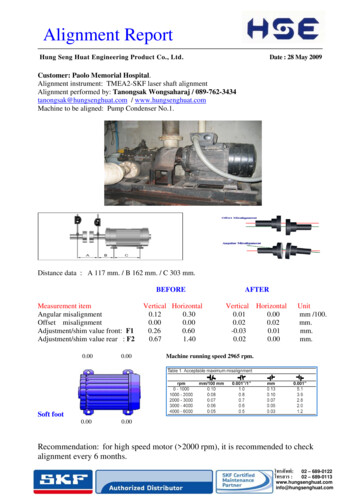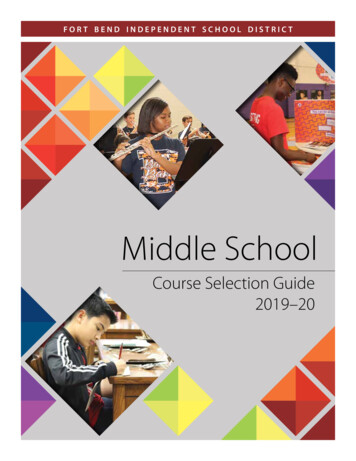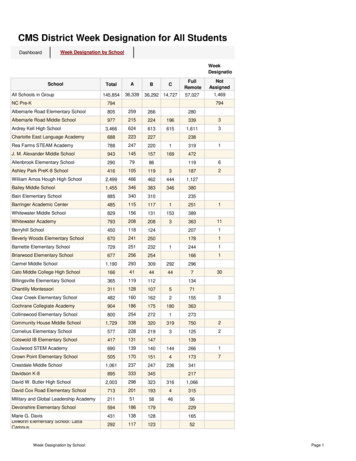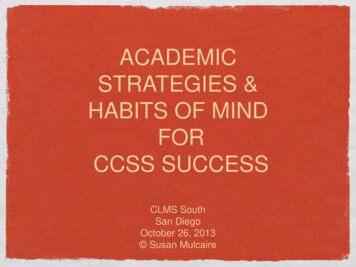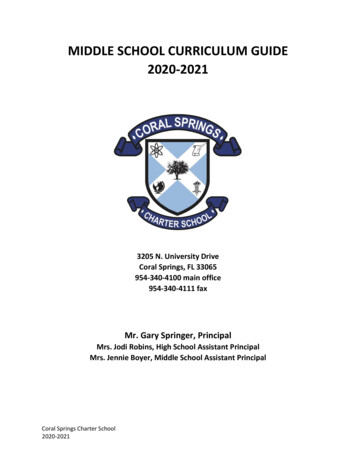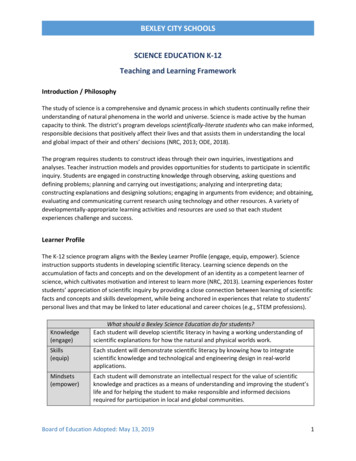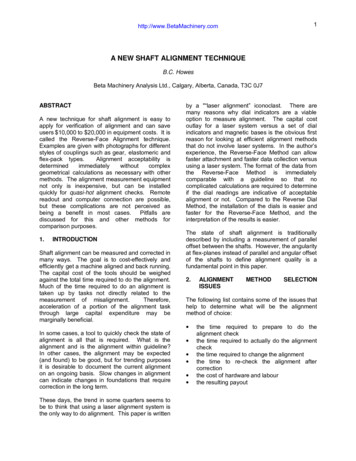
Transcription
The Search for LifeNational Aeronautics and Space AdministrationNRC Framework Middle School Alignment Document
National Aeronautics and Space AdministrationThe Search for LifeMiddle School NRC Framework for Science Education Alignment DocumentWHAT STUDENTS DO: Explore the key moments in Earth’s biogeological history.Students travel back in geologic time to explore some of the major historical events ofEarth in an attempt to understand the search for life on other planets in the universe.NRC FRAMEWORK/NGSS CORE & COMPONENT QUESTIONSWHAT IS THE UNIVERSE AND WHAT ISEARTH’S PLACE IN IT?INSTRUCTIONAL OBJECTIVES (IO)Students will be able toNGSS Core Question: ESS1: Earth’s Place in the universeIO1: Construct an argumentHow do people reconstruct and date events inEarth’s planetary history?NGSS ESS1.C: The History of Planet EarthHOW CAN THERE BE SO MANY SIMILARITIESAMONG ORGANISMS YET SO MANYDIFFERENT KINDS OF PLANTS, ANIMALS, ANDMICROORGANISMS?about the constraintsand limitationsregarding the search forlife in the universe usingevidence from Earth’srock record.NGSS Core Question: LS4: Biological Evolution: Unity and DiversityWhat evidence shows different species are related?NGSS LS4.A: Evidence of Common Ancestry and DiversityThis material is based upon work supported by NASA under cooperative agreement No. NNX16AD79A. Any opinions, findings, andconclusions or recommendations expressed in this material are those of the author(s) and do not necessarily reflect the views of theNational Aeronautics and Space Administration. This lesson was prepared by Arizona State University’s Education ThrougheXploration (ETX) Center. Lesson formatting was adopted and adapted from Arizona State University’s Mars Education Program.The lesson and its’ associated materials may be photocopied and distributed freely for non-commercial purposes. Copyright 20162021.Last edited: November 1, 2018
National Aeronautics and Space Administration1.0 About This ActivityHow Students Learn: Science in the Classroom (Donovan & Bransford, 2005) advocates theuse of a research-based instructional model for improving students’ grasp of central scienceconcepts. Based on conceptual-change theory in science education, the 5E Instructional Model(BSCS, 2006) includes five steps for teaching and learning: Engage, Explore, Explain,Elaborate, and Evaluate. The Engage stage is used like a traditional warm-up to pique studentcuriosity, interest, and other motivation-related behaviors and to assess students’ priorknowledge. The Explore step allows students to deepen their understanding and challengesexisting preconceptions and misconceptions, offering alternative explanations that help themform new schemata. In Explain, students communicate what they have learned, illustrating initialconceptual change. The Elaborate phase gives students the opportunity to apply their newfoundknowledge to novel situations and supports the reinforcement of new schemata or its transfer.Finally, the Evaluate stage serves as a time for students’ own formative assessment, as well asfor educators’ diagnosis of areas of confusion and differentiation of further instruction. The 5Estages can be cyclical and iterative.This material is based upon work supported by NASA under cooperative agreement No. NNX16AD79A. Any opinions, findings, andconclusions or recommendations expressed in this material are those of the author(s) and do not necessarily reflect the views of theNational Aeronautics and Space Administration. This lesson was prepared by Arizona State University’s Education ThrougheXploration (ETX) Center. Lesson formatting was adopted and adapted from Arizona State University’s Mars Education Program.The lesson and its’ associated materials may be photocopied and distributed freely for non-commercial purposes. Copyright 20162021.Last edited: November 1, 2018
National Aeronautics and Space Administration2.0 Instructional Objectives, Learning Outcomes, Standards, & RubricsVisit https://infiniscope.org/lesson/stories-in-rock/ for access to the digital learning experience,lesson plans, standards alignment documents, and additional resources.Instructional objectives and learning outcomes are aligned with National Research Council’s, A Framework for K-12 Science Education: Practices,Crosscutting Concepts, and Core Ideas National Governors Association Center for Best Practices (NGA Center) and Council ofChief State School Officers (CCSSO)’s, Common Core State Standards for EnglishLanguage Arts & Literacy in History/Social Studies, Science, and Technical SubjectsThe following chart provides details on alignment among the core and component NRCquestions, instructional objectives, learning outcomes, and educational standards. Your instructional objectives (IO) for this lesson align with the NRC Framework. You will know that you have achieved these instructional objectives if studentsdemonstrate the related learning outcomes (LO), also aligned with the NRCFramework. You will know the level to which your students have achieved the learning outcomes byusing the suggested rubrics.Important Note: This lesson is color-coded to help teachers identify each of the threedimensions of the NRC Framework. The following identifying colors are used: Practicesare blue, Cross-Cutting Concepts are green, and Disciplinary Core Ideas are orange.This color-coding is consistent with the NRC Framework for K-12 Science Education.Quick View of Standards Alignment:This alignment document provides full details of the way in which instructional objectives,learning outcomes, 5E activity procedures, and rubric assessments were derived through andalign with the NRC Framework for K-12 Education. For convenience, a quick view follows:This material is based upon work supported by NASA under cooperative agreement No. NNX16AD79A. Any opinions, findings, andconclusions or recommendations expressed in this material are those of the author(s) and do not necessarily reflect the views of theNational Aeronautics and Space Administration. This lesson was prepared by Arizona State University’s Education ThrougheXploration (ETX) Center. Lesson formatting was adopted and adapted from Arizona State University’s Mars Education Program.The lesson and its’ associated materials may be photocopied and distributed freely for non-commercial purposes. Copyright 20162021.Last edited: November 1, 2018
National Aeronautics and Space AdministrationWHAT IS THE UNIVERSE AND WHAT IS EARTH’S PLACE IN IT?NGSS Core Question: ESS1: Earth’s Place in the UniverseHow do people reconstruct and date events in Earth’s planetary history?NGSS ESS1.C: The History of Planet EarthHOW CAN THERE BE SO MANY SIMILARITIES AMONGORGANISMS YET SO MANY DIFFERENT KINDS OF PLANTS,ANIMALS, AND MICROORGANISMS?NGSS Core Question: LS4: Biological Evolution: Unity and DiversityWhat evidence shows different species are related?NGSS LS4.A: Evidence of Common Ancestry and DiversityInstructional ObjectiveStudents will be able toIO1: Construct anargumentabout theconstraintsand limitationsregarding thesearch for lifein the universeusingevidence fromEarth’s rockrecord.Learning OutcomesStudents will demonstrate themeasurable abilitiesStandardsStudents will addressLO1a: Explain howscientists piecetogether the storyof life from thefossil record.PRACTICES:LO1b: Construct anargument thatexplains thesignificance of theK-Pg boundaryand the evidencecontained in HellCreek thatdemonstrates thesignificance ofthis boundary.DISCIPLINARY CORE IDEAS:LO1c: Construct anexplanation forwhat evidencepoints to theexistence ofstromatolites inNorth Pole Dome,Australia and howthey aresignificant in thestory of life onEarth.1. Engaging in Argument from Evidence2. Constructing Explanations andDesigning SolutionsESS1.C: The History of Planet EarthLS4.A: Evidence of CommonAncestry and DiversityETS1.A: Defining and DelimitingEngineering ProblemsCROSSCUTTING CONCEPTS:1. Patterns2. Stability and ChangeInterdependence of Science,Engineering, and TechnologyInfluence of Science, Engineering,and Technology on Society and theNatural WorldThis material is based upon work supported by NASA under cooperative agreement No. NNX16AD79A. Any opinions, findings, andconclusions or recommendations expressed in this material are those of the author(s) and do not necessarily reflect the views of theNational Aeronautics and Space Administration. This lesson was prepared by Arizona State University’s Education ThrougheXploration (ETX) Center. Lesson formatting was adopted and adapted from Arizona State University’s Mars Education Program.The lesson and its’ associated materials may be photocopied and distributed freely for non-commercial purposes. Copyright 20162021.Last edited: November 1, 2018
National Aeronautics and Space Administration3.0 Evaluation/AssessmentUse the (N) The Search for Life Alignment Rubric as a formative assessment, allowing studentsto improve their work and learn from mistakes during class. The rubric evaluates the activitiesusing the NRC Framework.4.0 ReferencesBybee, R., Taylor, J., Gardner, A., Van Scotter, P., Carson Powell, J., Westbrook, A., Landes,N. (2006) The BSCS 5E instructional model: origins, effectiveness, and applications.Colorado Springs: BSCS.Donovan, S. & Bransford, J. D. (2005). How Students Learn: History, Mathematics, and Sciencein the Classroom. Washington, DC: The National Academies Press.Miller, Linn, & Gronlund. (2009). Measurement and assessment in teaching. Upper SaddleRiver, NJ: Pearson.National Academies Press. (1996, January 1). National science education standards. RetrievedFebruary 7, 2011 from http://www.nap.edu/catalog.php?record id 4962National Governors Association Center for Best Practices & Council of Chief State SchoolOfficers. (2010). Common Core State Standards. Washington, DC: Authors.National Research Council. (2012). A framework for K-12 science education: Practices,crosscutting concepts, and core ideas. Committee on a Conceptual Framework for NewK-12 Science Education Standards. Board on Science Education, Division of Behavioraland Social Sciences and Education. Washington, DC: The National Academies Press.This material is based upon work supported by NASA under cooperative agreement No. NNX16AD79A. Any opinions, findings, andconclusions or recommendations expressed in this material are those of the author(s) and do not necessarily reflect the views of theNational Aeronautics and Space Administration. This lesson was prepared by Arizona State University’s Education ThrougheXploration (ETX) Center. Lesson formatting was adopted and adapted from Arizona State University’s Mars Education Program.The lesson and its’ associated materials may be photocopied and distributed freely for non-commercial purposes. Copyright 20162021.Last edited: November 1, 2018
THE SEARCH FOR LIFE(M) Teacher Resource. The Search for Life NRC Framework for Science Education Alignment (1 of 3)Science and EngineeringPractices Benchmarkby Grade 8ESS1.C: The History of Planet EarthThe geological time scale interpreted from rockstrata provides a way to organize Earth’s history.Major historical events include the formation ofmountain chains and ocean basins, the evolutionand extinction of particular living organisms,volcanic eruptions, periods of massive glaciation,and development of watersheds and riversthrough glaciation and water erosion. Analyses ofrock strata and the fossil record provide onlyrelative dates, not an absolute scale.Disciplinary Core IdeaGrade Band EndpointsTeacher GuideInfluence of Science,Engineering, and Technologyon Society and the NaturalInterdependence of Science,Engineering, and TechnologyEngineering advances have led toimportant discoveries in virtuallyevery field of science, andscientific discoveries have led tothe development of entireindustries and engineeredsystems. In order to design bettertechnologies, new science mayneed to be explored (e.g.,materials research prompted bydesire for better batteries or solarcells, biological questions raisedby medical problems).Technologies in turn extend themeasurement, exploration,modeling, and computationalcapacity of scientificinvestigations.Crosscutting ConceptsYou will know the level to which your students have achieved the Learning Outcomes, and thus the InstructionalObjective(s), by using the suggested Rubrics below.InstructionalObjectiveEngaging in Argument fromEvidenceStudents can draw on a widerrange of reasons or evidence, sothat their arguments become moresophisticated. In addition, theyshould be expected to discernwhat aspects of the evidence arepotentially significant forsupporting or refuting a particularargument.NRC Framework for K-12 Science EducationIO1:Construct anargument aboutthe constraintsand limitationsregarding thesearch for life inthe universeusing evidencefrom Earth’s rockrecord.LS4.A: Evidence of Common Ancestry andDiversityFossils are mineral replacements, preservedremains, or traces of organisms that lived in thepast. Thousands of layers of sedimentary rock notonly provide evidence of the history of Earth itselfbut also of changes in organisms whose fossilremains have been found in those layers. Thecollection of fossils and their placement inchronological order (e.g., through the location ofthe sedimentary layers in which they are found orthrough radioactive dating) is known as the fossilrecord. It documents the existence, diversity,This material is based upon work supported by NASA under cooperative agreement No. NNX16AD79A. Any opinions, findings, and conclusions or recommendations expressed in thismaterial are those of the author(s) and do not necessarily reflect the views of the National Aeronautics and Space Administration. This lesson was prepared by Arizona StateUniversity’s Education Through eXploration (ETX) Center. Lesson formatting was adopted and adapted from Arizona State University’s Mars Education Program. The lesson and its’associated materials may be photocopied and distributed freely for non-commercial purposes. Copyright 2016-2021. Last edited: November 1, 2018
National Aeronautics and Space Administrationextinction, and change of many life formsthroughout the history of life on Earth. Because ofthe conditions necessary for their preservation,not all types of organisms that existed in the pasthave left fossils that can be retrieved. Anatomicalsimilarities and differences between variousorganisms living today and between them andorganisms in the fossil record enable thereconstruction of evolutionary history and theinference of lines of evolutionary descent.ETS1.A: Defining and Delimiting EngineeringProblemsThe more precisely a design task’s criteria andconstraints can be defined, the more likely it isthat the designed solution will be successful.Specification of constraints includes considerationof scientific principles and other relevantknowledge that are likely to limit possible solutions(e.g., familiarity with the local climate may rule outcertain plants for the school garden).WorldThe uses of technologies and anylimitations on their use are drivenby individual or societal needs,desires, and values; by thefindings of scientific research; andby differences in such factors asclimate, natural resources, andeconomic conditions.This material is based upon work supported by NASA under cooperative agreement No. NNX16AD79A. Any opinions, findings, and conclusions or recommendations expressed in thismaterial are those of the author(s) and do not necessarily reflect the views of the National Aeronautics and Space Administration. This lesson was prepared by Arizona StateUniversity’s Education Through eXploration (ETX) Center. Lesson formatting was adopted and adapted from Arizona State University’s Mars Education Program. The lesson and its’associated materials may be photocopied and distributed freely for non-commercial purposes. Copyright 2016-2021.Last edited: November 1, 2018
National Aeronautics and Space AdministrationTHE SEARCH FOR LIFEScience and EngineeringPractices Benchmark by Grade 8Disciplinary Core IdeaGrade Band EndpointsTeacher GuideCrosscutting ConceptsSchool Progression)Stability and ChangeRecognize that much of sciencedeals with constructing historicalexplanations of how things evolvedto be the way they are today, whichinvolves modeling rates of changeand conditions under which thesystem is stable or changesgradually, as well as explanations ofany sudden change. (Crosscutting High(M) Teacher Resource. The Search for Life NRC Framework for Science Education Alignment (2 of 3)Constructing Explanations andDesigning SolutionsConstruct their own explanations ofphenomena using their knowledge ofaccepted scientific theory and linkingit to models and evidence.NRC Framework for K-12 Science EducationLearning OutcomesLO1a:Explain howscientists piecetogether the storyof life from thefossil record.Offer causal explanationsappropriate to their level of scientificknowledge.ESS1.C: The History of Planet EarthThe geological time scale interpreted fromrock strata provides a way to organizeEarth’s history. Major historical eventsinclude the formation of mountain chains andocean basins, the evolution and extinction ofparticular living organisms, volcaniceruptions, periods of massive glaciation, anddevelopment of watersheds and riversthrough glaciation and water erosion.Analyses of rock strata and the fossil recordprovide only relative dates, not an absolutescale.LS4.A: Evidence of Common Ancestryand DiversityFossils are mineral replacements, preservedremains, or traces of organisms that lived inthe past. Thousands of layers of sedimentaryrock not only provide evidence of the historyof Earth itself but also of changes inorganisms whose fossil remains have beenfound in those layers. The collection offossils and their placement in chronologicalorder (e.g., through the location of theThis material is based upon work supported by NASA under cooperative agreement No. NNX16AD79A. Any opinions, findings, and conclusions or recommendations expressed in thismaterial are those of the author(s) and do not necessarily reflect the views of the National Aeronautics and Space Administration. This lesson was prepared by Arizona StateUniversity’s Education Through eXploration (ETX) Center. Lesson formatting was adopted and adapted from Arizona State University’s Mars Education Program. The lesson and its’associated materials may be photocopied and distributed freely for non-commercial purposes. Copyright 2016-2021.Last edited: November 1, 2018
Engaging in Argument fromEvidenceStudents can draw on a wider rangeof reasons or evidence, so that theirarguments become moresophisticated. In addition, theyshould be expected to discern whataspects of the evidence arepotentially significant for supportingor refuting a particular argument.National Aeronautics and Space AdministrationLO1b:Construct anargument thatexplains thesignificance of theK-Pg boundary andthe evidencecontained in HellCreek thatdemonstratesthesignificanceof this boundary.sedimentary layers in which they are foundor through radioactive dating) is known asthe fossil record. It documents the existence,diversity, extinction, and change of many lifeforms throughout the history of life on Earth.Because of the conditions necessary for theirpreservation, not all types of organisms thatexisted in the past have left fossils that canbe retrieved. Anatomical similarities anddifferences between various organisms livingtoday and between them and organisms inthe fossil record enable the reconstruction ofevolutionary history and the inference of linesof evolutionary descent. Comparison of theembryological development of differentspecies also reveals similarities that showrelationships not evident in the fully formedanatomy.ESS1.C: The History of Planet EarthThe geological time scale interpreted fromrock strata provides a way to organizeEarth’s history. Major historical eventsinclude the formation of mountain chains andocean basins, the evolution and extinction ofparticular living organisms, volcaniceruptions, periods of massive glaciation, anddevelopment of watersheds and riversthrough glaciation and water erosion.Analyses of rock strata and the fossil recordprovide only relative dates, not an absolutescale.LS4.A: Evidence of Common Ancestryand DiversityFossils are mineral replacements, preservedremains, or traces of organisms that lived inStability and ChangeExplain subtle or conditionalsituations and the need for feedbackto maintain stability.This material is based upon work supported by NASA under cooperative agreement No. NNX16AD79A. Any opinions, findings, and conclusions or recommendations expressed in thismaterial are those of the author(s) and do not necessarily reflect the views of the National Aeronautics and Space Administration. This lesson was prepared by Arizona StateUniversity’s Education Through eXploration (ETX) Center. Lesson formatting was adopted and adapted from Arizona State University’s Mars Education Program. The lesson and its’associated materials may be photocopied and distributed freely for non-commercial purposes. Copyright 2016-2021.Last edited: November 1, 2018
Offer causal explanationsappropriate to their level of scientificknowledge.Constructing Explanations andDesigning SolutionsConstruct their own explanations ofphenomena using their knowledge ofaccepted scientific theory and linkingit to models and evidence.National Aeronautics and Space AdministrationLO1c:Construct anexplanation forwhat evidencepoints to theexistence ofstromatolitesin North PoleDome, Australiaand how they aresignificant in thestory of life onEarth.the past. Thousands of layers of sedimentaryrock not only provide evidence of the historyof Earth itself, but also of changes inorganisms whose fossil remains have beenfound in those layers. The collection offossils and their placement in chronologicalorder (e.g., through the location of thesedimentary layers in which they are foundor through radioactive dating) is known asthe fossil record. It documents the existence,diversity, extinction, and change of many lifeforms throughout the history of life on Earth.Because of the conditions necessary for theirpreservation, not all types of organisms thatexisted in the past have left fossils that canbe retrieved. Anatomical similarities anddifferences between various organisms livingtoday and between them and organisms inthe fossil record enable the reconstruction ofevolutionary history and the inference of linesof evolutionary descent.ESS1.C: The History of Planet EarthThe geological time scale interpreted fromrock strata provides a way to organizeEarth’s history. Major historical eventsinclude the formation of mountain chains andocean basins, the evolution and extinction ofparticular living organisms, volcaniceruptions, periods of massive glaciation, anddevelopment of watersheds and riversthrough glaciation and water erosion.Analyses of rock strata and the fossil recordprovide only relative dates, not an absolutescale.PatternsRelate patterns to the nature ofmicroscopic and atomic-levelstructure.This material is based upon work supported by NASA under cooperative agreement No. NNX16AD79A. Any opinions, findings, and conclusions or recommendations expressed in thismaterial are those of the author(s) and do not necessarily reflect the views of the National Aeronautics and Space Administration. This lesson was prepared by Arizona StateUniversity’s Education Through eXploration (ETX) Center. Lesson formatting was adopted and adapted from Arizona State University’s Mars Education Program. The lesson and its’associated materials may be photocopied and distributed freely for non-commercial purposes. Copyright 2016-2021.Last edited: November 1, 2018
National Aeronautics and Space AdministrationRadioactive decay lifetimes and isotopiccontent in rocks provide a way of dating rockformations and thereby fixing the scale ofgeological time.LS4.A: Evidence of Common Ancestryand DiversityFossils are mineral replacements, preservedremains, or traces of organisms that lived inthe past. Thousands of layers of sedimentaryrock not only provide evidence of the historyof Earth itself but also of changes inorganisms whose fossil remains have beenfound in those layers. The collection offossils and their placement in chronologicalorder (e.g., through the location of thesedimentary layers in which they are foundor through radioactive dating) is known asthe fossil record. It documents the existence,diversity, extinction, and change of many lifeforms throughout the history of life on Earth.Because of the conditions necessary for theirpreservation, not all types of organisms thatexisted in the past have left fossils that canbe retrieved. Anatomical similarities anddifferences between various organisms livingtoday and between them and organisms inthe fossil record enable the reconstruction ofevolutionary history and the inference of linesof evolutionary descent. Comparison of theembryological development of differentspecies also reveals similarities that showrelationships not evident in the fully formedanatomy.This material is based upon work supported by NASA under cooperative agreement No. NNX16AD79A. Any opinions, findings, and conclusions or recommendations expressed in thismaterial are those of the author(s) and do not necessarily reflect the views of the National Aeronautics and Space Administration. This lesson was prepared by Arizona StateUniversity’s Education Through eXploration (ETX) Center. Lesson formatting was adopted and adapted from Arizona State University’s Mars Education Program. The lesson and its’associated materials may be photocopied and distributed freely for non-commercial purposes. Copyright 2016-2021.Last edited: November 1, 2018
National Aeronautics and Space AdministrationTHE SEARCH FOR LIFEScience and EngineeringPractices Benchmark byGrade 8Constructing Explanationsand Designing SolutionsConstruct their ownexplanations of phenomenausing their knowledge ofaccepted scientific theory andlinking it to models andevidence.Offer causal explanationsappropriate to their level ofscientific knowledge.Teacher GuideDisciplinary Core IdeaGrade Band EndpointsStability and ChangeExplain subtle or conditionalsituations and the need forfeedback to maintain stability.Crosscutting ConceptsPatternsRelate patterns to the nature ofmicroscopic and atomic-levelstructure.ESS1.C: The History of Planet EarthThe geological time scale interpreted fromrock strata provides a way to organizeEarth’s history. Major historical eventsinclude the formation of mountain chains andocean basins, the evolution and extinction ofparticular living organisms, volcaniceruptions, periods of massive glaciation, anddevelopment of watersheds and riversthrough glaciation and water erosion.Analyses of rock strata and the fossil recordprovide only relative dates, not an absolutescale.(M) Teacher Resource. The Search for Life NRC Framework for Science Education Individual Activity Alignment (3 of 3)ExploreEngagePhases of5EInstructionalModelNRC Framework for Science EducationActivity(A) ComplexLife in theUniverseEarthExplorations:Stories in RockExtinctionStory in HellCreekStory ofComplexAnimals inNilpenaEarliest Storiesof Life inAustraliaLS4.A: Evidence of Common Ancestryand DiversityFossils are mineral replacements, preservedremains, or traces of organisms that lived inthe past. Thousands of layers of sedimentaryrock not only provide evidence of the historyof Earth itself but also of changes inThis material is based upon work supported by NASA under cooperative agreement No. NNX16AD79A. Any opinions, findings, and conclusions or recommendations expressed in thismaterial are those of the author(s) and do not necessarily reflect the views of the National Aeronautics and Space Administration. This lesson was prepared by Arizona StateUniversity’s Education Through eXploration (ETX) Center. Lesson formatting was adopted and adapted from Arizona State University’s Mars Education Program. The lesson and its’associated materials may be photocopied and distributed freely for non-commercial purposes. Copyright 2016-2021.Last edited: November 1, 2018
ExplainOffer causal explanationsappropriate to their level ofscientific knowledge.Constructing Explanationsand Designing SolutionsConstruct their ownexplanations of phenomenausing their knowledge ofaccepted scientific theory andlinking it to models andevidence.National Aeronautics and Space Administration(B) Stories inRock(C) VisitingDeep Time(D) ExtinctionStory in HellCreek(E) ClassifyingOrganisms byPhylogenyorganisms whose fossil remains have beenfound in those layers. The collection offossils and their placement in chronologicalorder (e.g., through the location of thesedimentary layers in which they are foundor through radioactive dating) is known asthe fossil record. It documents the existence,diversity, extinction, and change of many lifeforms throughout the history of life on Earth.Because of the conditions necessary for theirpreservation, not all types of organisms thatexisted in the past have left fossils that canbe retrieved. Anatomical similarities anddifferences between various organisms livingtoday and between them and organisms inthe fossil record enable the reconstruction ofevolutionary history and the inference of linesof evolutionary descent. Comparison of theembryological development of differentspecies also reveals similarities that showrelationships not evident in the fully formedanatomy.ESS1.C: The History of Planet EarthThe geological time scale interpreted fromrock strata provides a way to organizeEarth’s history. Major historical eventsinclude the formation of mountain chains andocean basins, the evolution and extinction ofparticular living organisms, volcaniceruptions, periods of massive glaciation, anddevelopment of watersheds and riversthrough glaciation and water erosion.Analyses of rock strata and the fossil recordprovide only rel
National Research Council. (2012). A framework for K-12 science education: Practices, crosscutting concepts, and core ideas. Committee on a Conceptual Framework for New K-12 Science Education Standards. Board on Science Education, Division of Behavioral and Social Sciences and Education. Washi

